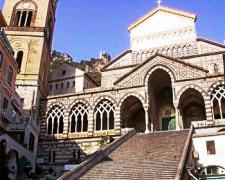Amalfi Activities
Amalfi's Civic Musem
Amalfi's
Particularly interesting is the XV century wording of the "Tabula Amalphitana", a precious maritime code dating back to the famous
Amalfi's
Located in an ancient XIV century medieval paper-mill, along the road to the
Valle delle
At the heart of the
The natural habitat gives birth to species of plants rarely found in Italy, such as theWoodwardia radicands fern, a sort of living fossil, dating back to the Tertiary period.
The valley is also well known for its paper mills - the oldest in
The Emerald Grotto Amalfi Coast
The Emerald Grotto is set in the charming
An interesting feature: the underwater pottery crib.
Valle dei Mulini (Valley of the Mills) Review
The Valle dei Mulini, uphill from town, was for centuries Amalfi's center for papermaking, an ancient trade learned from the Arabs (who learned it from the Chinese). Beginning in the 12th century, former flour mills in the town were converted to produce paper made from cotton and linen, being among the first in
The Amalfi Duomo (Sant’Andrew Cathedral)
The "Duomo" was built in the IX Century, when the
The current façade of the "Duomo", decorated with thin layers of gold, was rebuilt, together with the long and grandiose stairway, in 1891. It is adorned in impressive mosaic, rich in forms and vivid colours, representing Christ sitting on his throne among the Evangelists.
This masterpiece was created by Salviati of Venice from a draft produced by Domenico Morelli.
The "Duomo" has a superb Romanesque bell tower, completed in 1276, decorated in majolica mosaics, and restored in 1929. Adjacent to the Duomo is the enchanting "Chiostro del Paradiso", of Arab style and decorated with intertwining arches leaning on coupled columns, it dates back to 1266 and preserves within finds of the Roman and Medieval eras. It is said to be the most beautiful part of the Duomo, hence its name (Cloister of Paradise).
The magnificent Crypt that preserves the remains of Saint Andrew, patron saint of Amalfi, is also incredibly important. It was built in the XIII century to receive the remains of the saint brought from the East during the Fourth Crusade.
Out of the 16 paper mills active at the end of the XVIII century, to this day, only about ten of them are still producing hand-made paper of the very best quality.
Agriculture Museum
Near the "Cartiera Amatruda", there is the Museo dell'Agricoltura, where we can see rudimental machines and various instruments of the last four centuries. With these instruments, for century the amalphitain farmer produced the famous lemon called “sfusato amalfitano ”.
Amalfi Boat Tours
Different kind of fishing are possible but the most required is the throwing fishing during a boat tour of the
There are many fine ceramic shops along the Piazza Duomo. The
In same day of the week there is a typical local market where you can buy many local product and dresses.
Hiking
If you like hiking you must do it on the
The pathways that open the way between the rugged mountains of the Amalfi coast offer breathtaking views of sea and sky, a true paradise for those who like bushwalking and trekking. For an unforgettable day, all you need is comfortable and suitable shoes, a camera and a passion for walks in the open air.
Wandering along the pathways, and stairs of Amalfi, or Atrani, Ravello, Agerola, etc. is a very exciting experience. Amazing views are just in every corner and you can reach the other beautiful towns in an hour or two along the recommended paths.
 Wedding Ceremony in Amalfi
A very exclusive location for religious and symbolic weddings.
Wedding Ceremony in Amalfi
A very exclusive location for religious and symbolic weddings.
 Wedding Reception in Amalfi
Amalfi offers very suggestive and various location for a wedding reception to remember
Wedding Reception in Amalfi
Amalfi offers very suggestive and various location for a wedding reception to remember

Social Networks